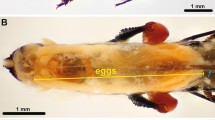Summary
The development of the aesthetascs of Neomysis integer (Malacostraca, Mysidacea) and Idotea baltica (Malacostraca, Isopoda) were investigated by electron microscope methods. Basically the aesthetascs of both species develop according to the same pattern. The newly formed sensillar shafts lie invaginated within the epidermal tissue. They are formed by numerous enveloping cells, which are arranged telescopically one by one. Each enveloping cell secretes a definite portion of the new shaft cuticle. The innermost enveloping cell extends furthest distally and deposits the cuticle of the future shaft tip. The outer enveloping cells produce the cuticle of the more proximal shaft portions. Whereas the morphogenesis of the aesthetascs of both species is uniform, the moulting processes are different. In the aesthetascs of Neomysis the morphological basis for a continuation of the sensitivity remains until ecdysis, as an intact dendritic connection between the sensory cells and the old shaft is maintained. In Idotea, the aesthetascs cease to function during the early moulting stages.
Similar content being viewed by others
References
Ache BW (1977) Aspects of chemoreception in marine crustacea. In: Le Magnen J, Mac Leod P (ed) Olfaction and taste VI. Information Retrieval, London & Washington DC, pp 343–350
Aiken DE (1973) Proecdysis, setal development, and molt prediction in the American Lobster (Homarus americanus). J Fish Res Board Can 30:1337–1344
Altner H, Thies G (1972) Reizleitende Strukturen und Ablauf der Häuting an Sensillen einer euedaphischen Collembolenart. Z Zellforsch Mikrosk Anat 129:196–216
Dexter BL (1981) Setogenesis and molting in planktonic crustaceans. J Plankton Res 3:1–13
Drach P, Tchernigovtzeff C (1967) Sur la méthode de détermination des stades d'intermue et son application générale aux Crustacées. Vie et Milieu A 18:595–609
Ernst K-D (1972) Die Ontogenie der basiconischen Riechsensillen auf der Antenne von Necorophorus (Coleoptera) Z Zellforsch Mikrosk anat 129:217–236
Ghiradella H, Case J, Cronshow J (1968) Structure of the aesthetascs in selected marine and terrestrial decapods. Chemoreceptor morphology and environment. Am Zool 8:603–621
Gnatzy W, Schmidt K (1972) Die Feinstruktur der Sinneshaare auf den Cerci von Gryllus bimaculatus Deg. (Saltatoria, Gryllidae). IV. Die Häutung der kurzen Borstenhaare. Z Zellforsch Mikrosk Anat 126:223–239
Gnatzy W, Tautz J (1977) Sensitivity of an insect mechanoreceptor during moulting. Physiol Entomol 2:279–288
Gnatzy W, Romer F (1980) Morphogenesis of mechanoreceptor and epidermal cells of crickets during the last instar, and its relation to molting-hormone level. Cell Tissue Res 213:369–391
Gnatzy W (1978) Development of the filiform hairs on the cerci of Gryllus bimaculatus Deg. (Saltatoria, Gryllidae). Cell Tissue Res 187:1–24
Guse G-W (1978) Antennal sensilla of Neomysis integer (Leach). Protoplasma 95:145–161
Guse G-W (1979) Feinstruktur der Aesthetasken von Neomysis integer (Leach) (Crustacea, Mysidacea). Zool Anz 203:170–176
Guse G-W (1980a) Development of antennal sensilla during moulting in Neomysis integer (Leach) (Crustacea, Mysidacea). Protoplasma 105:53–67
Guse G-W (1980b) Fine structure of sensilla during moulting in Neomysis integer (Leach) (Crustacea, Mysidacea). Experientia 36:1382–1384
Harris DJ (1977) Hair regeneration during moulting in the spider Ciniflo similis (Araneae, Dictynidae). Zoomorphologie 88:37–63
Haupt J, Coineau Y (1978) Moulting and morphogenesis of sensilla in a prostigmate mite. Cell Tissue Res 186:63–79
Haupt J (1982) Hair regeneration in a solfugid chemotactile sensillum during moulting (Arachnida: Solifugae). Wilhelm Roux's Archives 191:137–142
Keil T (1978) Die Markochaeten auf dem Thorax von Calliphora vicinia Robineau-Desvoidy (Calliphoridae, Diptera). Feinstruktur und Morphogenese eines epidermalen Insektenmechanoreceptors. Zoomorphologie 90:151–180
Larink O (1976) Entwicklung und Feinstruktur der Schuppen bei Lepismatiden und Machiliden (Insecta, Zygentoma und Archaeognatha). Zool Jahrb Anat Ontog Tiere 95:252–293
McIver SB (1975) Structure of cuticular mechanoreceptors of arthropods. Ann Rev Ent 20:381–397
Moran DT, Rowley JC, Zill SN, Varela FG (1976) The mechanism of sensory transduction in a mechanoreceptor. J Cell Biol 71:832–847
Reaka ML (1975) Molting in stomatopod crustaceans. I. Stages of the molt cycle, setagenesis, and morphology. J Morphol 146:55–80
Rieder N, Spaniol H (1980) Die Rezeptoren an den ersten Antennen von Leptestheria dahalacensis Rüppel (Crustacea, Conchostraca). Zoomorphologie 95:169–179
Risler H (1977) Die Sinnesorgane der Antennula von Porcellio scaber Latr. (Crustacea, Isopoda). Zool Jahrb Anat Ontog Tiere 98:29–52
Schmidt K, Gnatzy W (1971) Die Feinstruktur der Sinneshaare auf den Cerci von Gryllus bimaculatus Deg. (Saltatoria, Gryllidae). II. Die Häuting der Faden und Keulenhaare. Z Zellforsch Mikrosk Anat 122:210–226
Snow PJ (1973) Ultrastructure of the aesthetasc hairs of the littoral decapod, Paragrapsus gaimardii. Z Zellforsch Mikrosk Anat 138:489–503
Tchernigovtzeff C (1976) Sur l'organisation des matrices sétigères chez deux Crustacés Malacostracés, étudiée au microscope électronique. CR Acad Sc Paris D 282:727–729
Walcott C, Salpeter MM (1966) The effect of molting upon the vibration receptor of the spider (Achaearanea tepidariorum). J Morphol 119:383–392
Zacharuk RY (1980) Ultrastructure and function of insect chemosensilla. Ann Rev Ent 25:27–47
Author information
Authors and Affiliations
Rights and permissions
About this article
Cite this article
Guse, G.W. Ultrastructure, development, and moulting of the aesthetascs of Neomysis integer and Idotea baltica (Crustacea, Malacostraca). Zoomorphology 103, 121–133 (1983). https://doi.org/10.1007/BF00312242
Received:
Issue Date:
DOI: https://doi.org/10.1007/BF00312242




